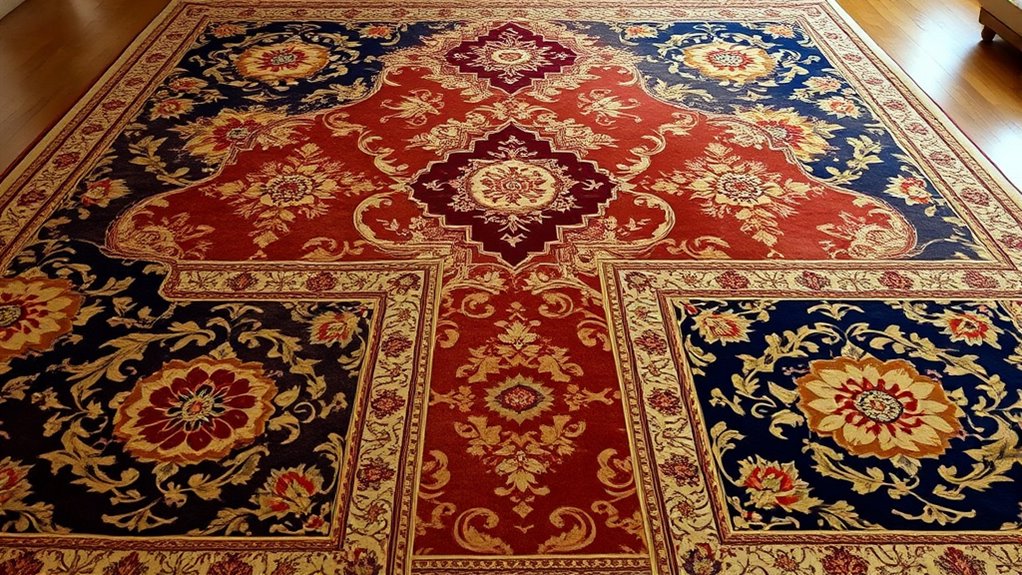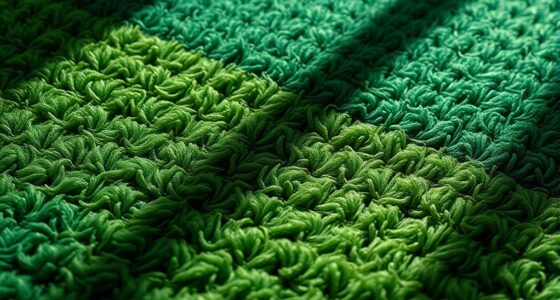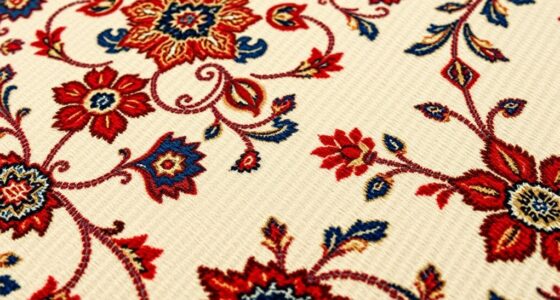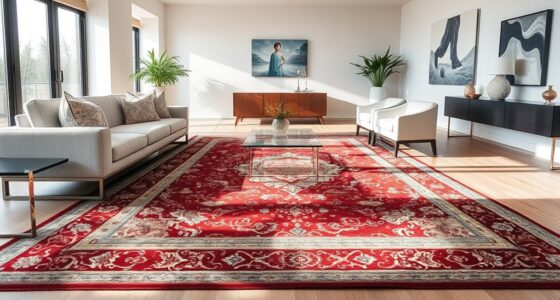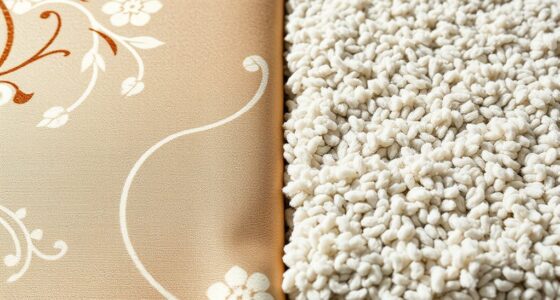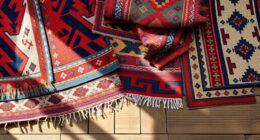French Savonnerie carpets are true icons of craftsmanship and history, known for their vibrant colors and intricate motifs that reflect regional influences and cultural stories. As a collector, you’ll want to recognize authentic handwoven pieces, pay attention to traditional techniques, and understand regional variations. Proper care and provenance are crucial for preserving value. If you continue exploring, you’ll gain deeper insights into spotting genuine treasures and building a timeless collection.
Key Takeaways
- Savonnerie carpets originated in 17th-century France, symbolizing luxury, status, and cultural heritage.
- They feature vibrant colors, floral motifs, medallions, and regional variations reflecting local craftsmanship.
- Handwoven with natural dyes, these carpets showcase intricate patterns, symbolic motifs, and artisan mastery.
- Authentic pieces exhibit meticulous craftsmanship, natural dyes, and slight irregularities; synthetic dyes and machine-made reproductions are common forgeries.
- Proper care, provenance verification, and expert appraisal are essential for preserving value and authenticity in collecting Savonnerie carpets.
The Historical Roots of Savonnerie Carpets

The origins of Savonnerie carpets trace back to 17th-century France, where artisans began developing a distinctive style of handmade rugs. During this period, French textile history blossomed as craftsmen combined artistic techniques with cultural influences. These carpets quickly became symbols of status and power, with intricate designs conveying specific meanings through carpet symbolism. You’ll notice that Savonnerie carpets reflect France’s rich textile heritage, blending craftsmanship with royal patronage. Their production was closely linked to the court, especially under Louis XIV, emphasizing luxury and tradition. As you explore these carpets, keep in mind that their roots are deeply embedded in France’s artistic and cultural evolution, making them not just decorative items but also historical artifacts that embody centuries of French textile mastery and symbolic storytelling. Additionally, emotional intelligence played a role in the design process, as artisans infused their work with cultural narratives and symbolic motifs that resonated with viewers.
Key Design Elements and Motifs

Savonnerie carpets are renowned for their intricate motifs and distinctive design elements that reflect both artistic skill and cultural symbolism. You’ll notice vibrant color palettes, often featuring rich reds, golds, blues, and greens, which enhance their luxurious appeal. The motifs themselves serve symbolic purposes; floral patterns symbolize growth and renewal, while medallions often represent unity or spiritual harmony. Scrolls, acanthus leaves, and geometric shapes are common, each carrying historical or regional significance. These design elements are carefully chosen to create harmonious, balanced compositions that draw attention to their craftsmanship. Understanding the motif symbolism and color choices helps you appreciate the cultural depth embedded in each carpet, making them not just decorative pieces but storytelling artifacts rooted in French artistic tradition. Additionally, the performance and reliability of these carpets are often enhanced by traditional weaving techniques, ensuring their durability and timeless beauty.
The Craftsmanship Behind Each Piece
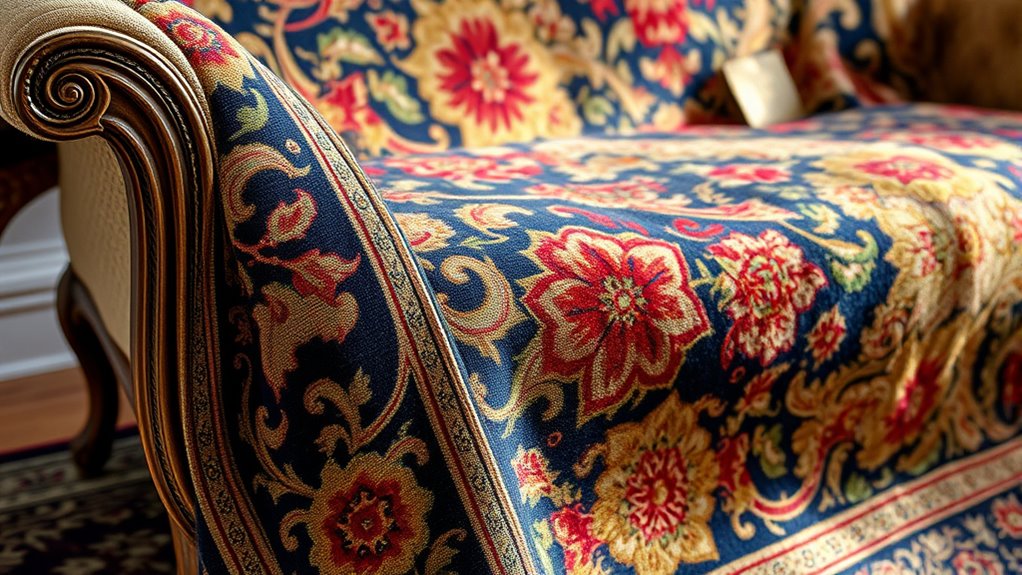
You can see the skill in every Savonnerie carpet through traditional weaving techniques that require patience and precision. Rich symbolic motifs are carefully incorporated, telling stories and reflecting cultural meanings. Each piece features handcrafted detailing that highlights the artisan’s dedication and mastery. In addition, the intricate designs and patterns often draw inspiration from historical and cultural cybersecurity vulnerabilities, emphasizing the importance of safeguarding such valuable artifacts.
Traditional Weaving Techniques
Traditional weaving techniques form the foundation of French savonnerie carpets, showcasing craftsmanship passed down through generations. You’ll notice the meticulous dyeing process, where natural dyes are carefully prepared to achieve vibrant, durable colors. This step guarantees that each hue complements the intricate weaving patterns, which are often symmetrical and highly detailed. As you observe the weaving, you’ll see how artisans skillfully interlace threads to create complex motifs and textures, reflecting both artistic expression and technical mastery. The precision involved in these techniques guarantees the durability and beauty of each carpet, preserving traditional methods while allowing for subtle artistic variations. Incorporating budgeting tips can help collectors allocate resources efficiently to acquire authentic pieces without overspending. Understanding this craftsmanship helps you appreciate the skill and care that make each savonnerie carpet a true masterpiece.
Rich Symbolic Motifs
Each French savonnerie carpet is a canvas rich with symbolic motifs that reflect cultural stories, beliefs, and history. The symbolic symbolism woven into each design reveals deeper meanings, often representing prosperity, protection, or spiritual ideals. You’ll notice a remarkable motif diversity—floral patterns, animals, and geometric shapes—all carefully chosen to convey specific messages or traditions. These motifs aren’t random; they embody centuries of craftsmanship and cultural significance, making each carpet a storytelling masterpiece. As you examine the intricate details, you’ll appreciate how each symbol enhances the visual richness while conveying a meaningful message. This layered symbolism transforms a beautiful textile into a cultural artifact, capturing the essence of French decorative arts and history. Moreover, understanding the cultural symbolism behind these motifs enriches your appreciation for their historical and artistic value.
Handcrafted Detailing
The intricate symbolism woven into French savonnerie carpets is brought to life through meticulous handcrafted detailing. Each piece showcases the skill of artisans who carefully select fiber materials like wool and silk for durability and luster. You’ll notice their expertise in dyeing methods, which produce vibrant, lasting colors. These craftsmen use traditional techniques, often hand-dyeing fibers to achieve subtle shades and rich hues that enhance the detailed motifs. Every knot and stitch reflects precision and dedication, ensuring the design’s clarity and symmetry. The craftsmanship involves multiple steps—from sketching complex patterns to final finishing touches—highlighting the artistry behind each carpet. This attention to detail makes savonnerie carpets true masterpieces of textile art, prized by collectors worldwide. Additionally, understanding the handmade techniques involved can deepen appreciation for their cultural significance and artistic value.
Recognizing Authenticity and Quality

To guarantee you’re getting an authentic French Savonnerie carpet, focus on examining its craftsmanship and materials. Authentic pieces display meticulous craftsmanship, especially in dyeing techniques that produce vibrant, durable colors. Look closely at the pile and motifs; genuine carpets have intricate, handwoven details. Be cautious of modern reproductions, which often use synthetic dyes and machine-made patterns. Recognize authenticity with this comparison:
| Feature | Authentic Savonnerie | Modern Reproductions |
|---|---|---|
| Dyeing Techniques | Hand-dyed, rich, layered colors | Machine-dyed, often flat or inconsistent colors |
| Material | Natural wool or silk | Synthetic fibers |
| Pattern Precision | Slight irregularities, handcrafted | Perfect uniformity, machine-made |
Always verify craftsmanship and materials for true quality. Additionally, understanding the global entertainment industry can provide insight into the cultural significance and market value of these rare carpets.
Variations and Regional Influences
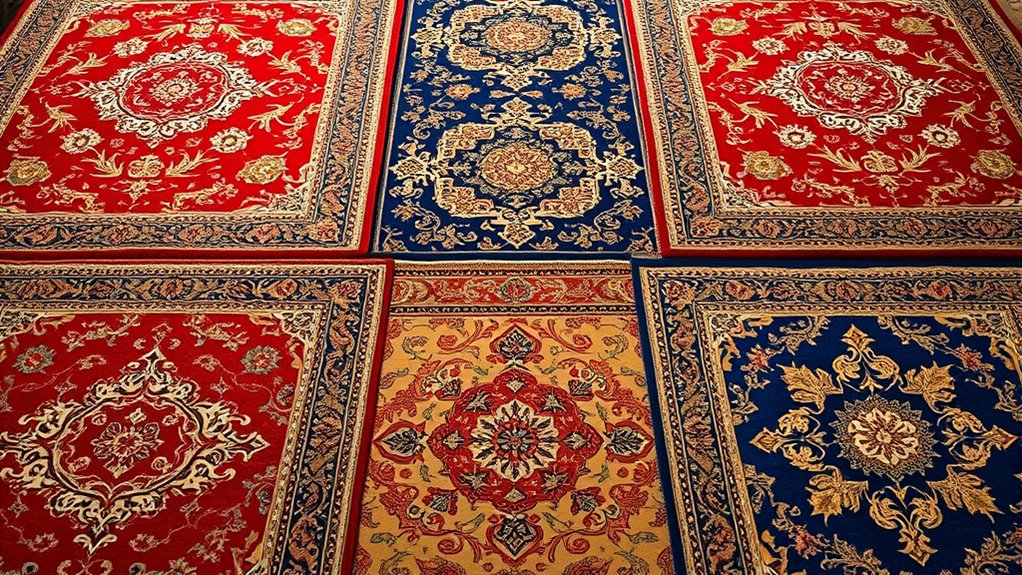
French Savonnerie carpets showcase a rich diversity of styles that reflect regional influences and local traditions. You’ll notice distinct variations in patterns, motifs, and color palettes depending on their place of origin. Regional color palettes often feature specific hues, such as warm earth tones in Provence or vibrant reds and blues in Lorraine. Artisan regional styles influence design motifs, with some areas favoring intricate floral arrangements, while others emphasize geometric patterns. These differences highlight the local craftsmanship and cultural heritage embedded in each piece. Recognizing these subtle variations helps you appreciate the uniqueness of each carpet and trace its provenance. Understanding regional influences enriches your collection, allowing you to see beyond the surface and connect with France’s diverse artisan traditions. Notably, Textile Line provides detailed insights into these regional characteristics, aiding collectors in identifying authentic and regionally distinctive carpets.
Proper Care and Preservation Tips
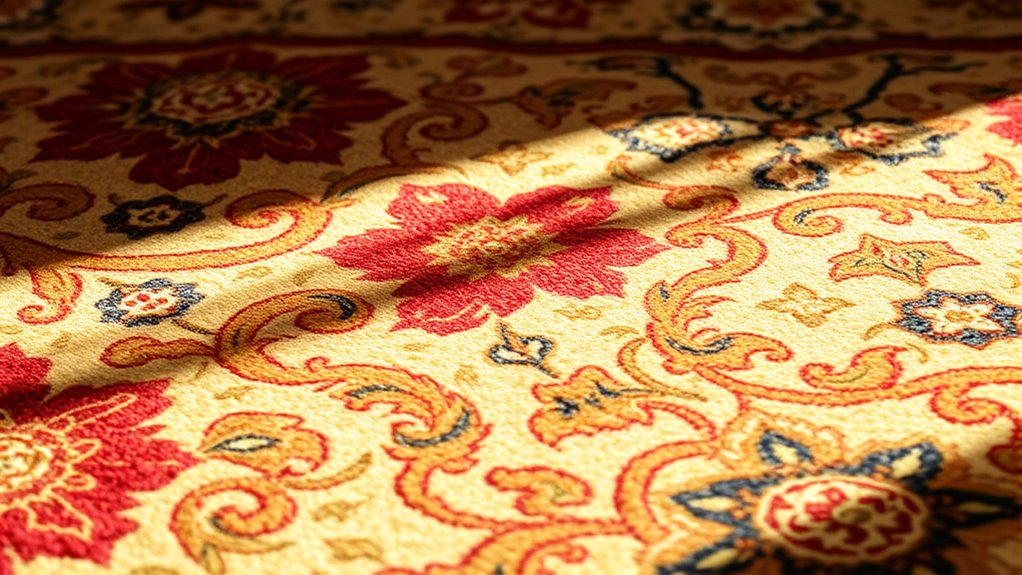
Proper care and preservation are essential to maintain the beauty and integrity of your Savonnerie carpets. To preserve their vibrant dyes, avoid excessive sunlight exposure, which can cause fading. Regularly vacuum gently to remove dust without damaging the fibers, and address stains promptly with professional cleaning methods suited for antique textiles. When storing your carpet, use proper storage techniques: roll it rather than fold to prevent creases, and keep it in a breathable container to avoid moisture buildup. Maintain a stable environment with low humidity and consistent temperature to prevent fiber deterioration. Avoid chemical cleaners or harsh treatments, as they can compromise dye preservation. Additionally, choosing appropriate heating methods can help prevent damage caused by fluctuations in temperature and humidity. With careful handling and appropriate storage, your Savonnerie carpet will remain a stunning and valuable piece for generations.
Valuation and Collecting Strategies
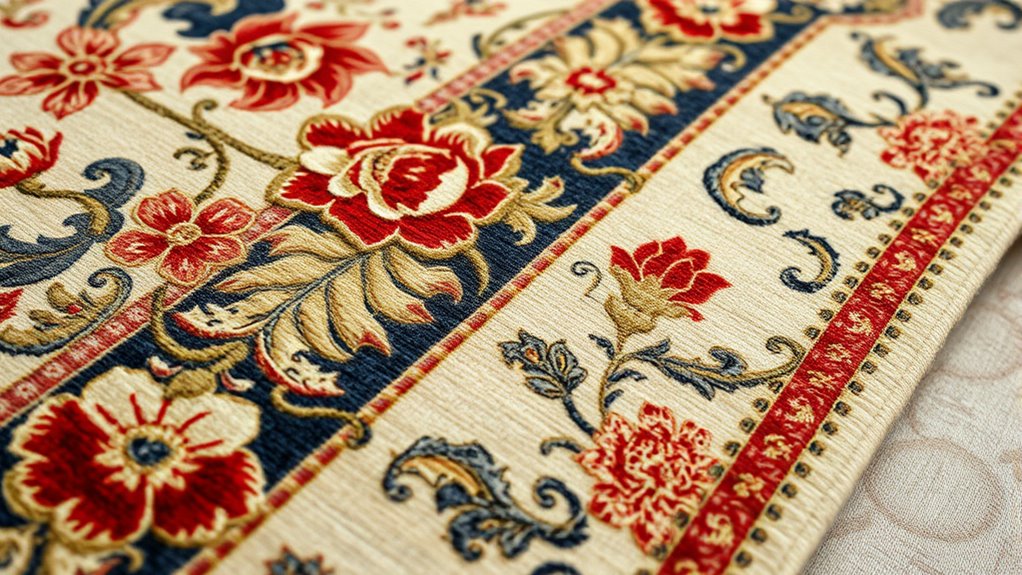
Understanding the true value of your Savonnerie carpet requires careful research and strategic collecting practices. To accurately assess worth, consider auction house evaluations, which provide expert appraisals based on market trends. Provenance verification is also vital, as authentic history boosts value and confidence in your piece. Developing a collecting strategy involves identifying reputable sources, documenting your carpet’s history, and staying informed on market fluctuations. You should also compare similar pieces and consult specialists to refine your approach. By combining expert evaluations with thorough provenance checks, you guarantee your investment is sound. Remember, a well-documented history and expert appraisals greatly enhance your Savonnerie carpet’s desirability and resale potential. Regularly monitoring market fluctuations and adjusting your collecting tactics accordingly can further optimize your investment.
Frequently Asked Questions
How Did Savonnerie Carpets Influence European Interior Design Trends?
Savonnerie carpets profoundly influenced European interior design by introducing intricate patterns and rich symbolism that elevated aesthetic standards. You’ll notice their detailed craftsmanship shaping the European aesthetic evolution, inspiring opulent decor styles. Their design symbolism often reflected cultural themes, encouraging a blend of artistry and functionality. As a result, these carpets became a hallmark of luxury, shaping trends that emphasized ornate, sophisticated interiors across European aristocratic and royal settings.
Are There Modern Reproductions of Savonnerie Carpets Available Commercially?
Imagine holding a piece of history in your hands—today’s reproductions of Savonnerie carpets bring that legacy to modern spaces. You’ll find these reproductions crafted with advanced techniques like digital printing and hand-knotting, blending traditional artistry with contemporary design. These modern adaptations allow you to enjoy the opulence and intricate patterns of classic Savonnerie carpets without the rarity or cost, making timeless elegance accessible for your personal or commercial interiors.
What Are Common Misconceptions About the Age and Origin of These Carpets?
You might believe that all Savonnerie carpets are ancient or that their origin myths are well-established, but age misconceptions often arise. Many think they’re all from the 17th or 18th century, yet some are more recent reproductions. Be cautious, as the origin myths can be exaggerated or misunderstood, making it tricky to determine the true age and provenance. Always verify provenance to avoid misconceptions about these exquisite textiles.
How Do Regional Influences Affect the Symbolism in Savonnerie Motifs?
You see regional influences shape savonnerie motifs by infusing them with local symbols, cultural motifs, and traditional patterns that tell regional stories. These influences influence the color choices, design elements, and symbolic representations, creating a tapestry of regional identity. By understanding regional symbols and cultural motifs, you gain insight into the history and cultural significance behind each carpet, appreciating how geography and local tradition weave into the artistry of savonnerie craftsmanship.
Can Savonnerie Carpets Be Integrated Into Contemporary Interior Aesthetics?
You can definitely integrate savonnerie carpets into contemporary interiors by focusing on textile blending and color harmony. These carpets add rich texture and intricate designs that contrast beautifully with modern minimalism. Choose pieces with subdued or complementary colors to guarantee they blend seamlessly. Their timeless elegance can serve as statement accents, creating a unique fusion of classic charm and contemporary style that elevates your space effortlessly.
Conclusion
While collecting Savonnerie carpets might seem intimidating or costly, their timeless beauty and rich history make it worth the effort. Don’t let fears of authenticity or maintenance hold you back—you can enjoy these masterpieces with proper care and knowledge. With patience, you’ll find that owning a piece of French craftsmanship not only elevates your space but also connects you to centuries of artistry. Start your collection today and cherish these iconic textiles for generations to come.
